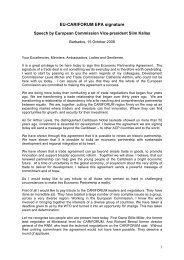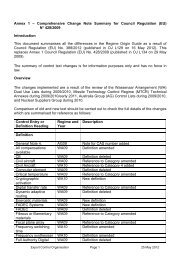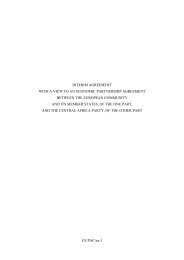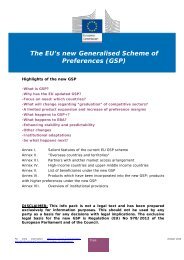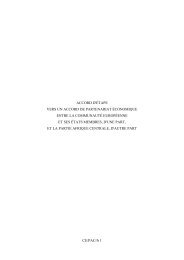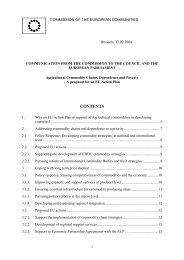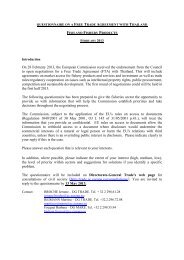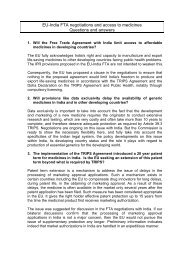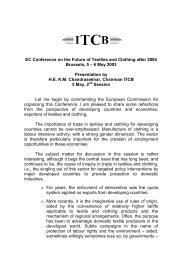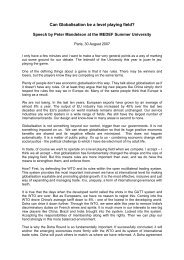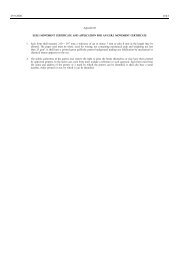Report on the Implementation of the derogation to ... - Trade Websites
Report on the Implementation of the derogation to ... - Trade Websites
Report on the Implementation of the derogation to ... - Trade Websites
Create successful ePaper yourself
Turn your PDF publications into a flip-book with our unique Google optimized e-Paper software.
Final <str<strong>on</strong>g>Report</str<strong>on</strong>g><br />
RoO Derogati<strong>on</strong> under <strong>the</strong> PACP-IEPA<br />
as l<strong>on</strong>g as PNG catch and effort are harm<strong>on</strong>ized within overall regi<strong>on</strong>al limits and can be<br />
accommodated within existing mechanisms and rules, <strong>the</strong>n some flexibility in <strong>the</strong> distributi<strong>on</strong> <strong>of</strong><br />
catch and effort is permitted for migra<strong>to</strong>ry/mobile species. However, <strong>the</strong>re are c<strong>on</strong>cerns that such<br />
harm<strong>on</strong>izati<strong>on</strong> is not occurring.<br />
PNG has no specific management measures such as effort or catch limits in place for archipelagic<br />
waters (AW), which make up 26% <strong>of</strong> PNG waters by area, but have c<strong>on</strong>tributed proporti<strong>on</strong>ally less <strong>of</strong><br />
<strong>the</strong> <strong>to</strong>tal catch (10-15% in most recent years). However, this is <strong>of</strong> potential c<strong>on</strong>cern since AW are<br />
exempt from VDS allocati<strong>on</strong>s and thus, outside existing PNA effort regulati<strong>on</strong>. In additi<strong>on</strong>, licences<br />
associated with new processing plants are likely <strong>to</strong> be linked <strong>to</strong> AW access, at least in case <strong>of</strong> smaller<br />
vessels. In practice, and especially with <strong>the</strong> c<strong>on</strong>siderable increase in effort and catch during 2010 and<br />
2011 in <strong>the</strong> PNG EEZ waters which largely surround <strong>the</strong> AW, fish availability in AW has been reduced,<br />
with resulting lower catch rates than in EEZ waters. 187 It is likely that effort in <strong>the</strong> already heavily<br />
fished AW will become self regulating, as vessels regularly leave AW in search <strong>of</strong> better catch rates in<br />
<strong>the</strong> more extensive EEZ waters. Local depleti<strong>on</strong> as result <strong>of</strong> increased effort in AW is not seen as an<br />
issue for migra<strong>to</strong>ry tunas, with replenishment likely <strong>to</strong> be rapid <strong>on</strong>ce effort is reduced, and no<br />
permanent damage sustained <strong>to</strong> s<strong>to</strong>cks in AW waters. In <strong>the</strong> l<strong>on</strong>g term, it would be desirable <strong>to</strong><br />
remove <strong>the</strong> AW exempti<strong>on</strong>s from <strong>the</strong> VDS, although this in itself would not prevent temporary local<br />
depleti<strong>on</strong>.<br />
PNG has l<strong>on</strong>g had high logsheet coverage <strong>of</strong> its purse seine and l<strong>on</strong>gline fleets (> 80% coverage),<br />
backed up by an efficient licensing system for foreign and domestic/locally based vessels, with<br />
associated licensing c<strong>on</strong>diti<strong>on</strong>s which reflect domesticati<strong>on</strong> policy. PNG/NFA has l<strong>on</strong>g carried out its<br />
own data entry, and compiles authoritative catch and export summaries for <strong>the</strong> WCPFC Annual<br />
<str<strong>on</strong>g>Report</str<strong>on</strong>g> Part 1. 189<br />
There is a large PNG nati<strong>on</strong>al observer programme covering all fisheries, including tuna, with over<br />
200 trained observers currently <strong>on</strong> <strong>the</strong> roster, and plans <strong>to</strong> expand this <strong>to</strong> more than 400. Average<br />
tuna vessel observer coverage, over <strong>the</strong> past 6 years <strong>to</strong> 2009, even prior <strong>to</strong> 100% coverage<br />
requirements, has been 86% for PNG domestic vessels, 61% for chartered vessels and 29% for<br />
foreign vessels. In 2010, under <strong>the</strong> requirements <strong>of</strong> CM 2008-01, close <strong>to</strong> 100% coverage <strong>of</strong> foreign<br />
vessels was achieved, as was <strong>the</strong> case for <strong>the</strong> regi<strong>on</strong>, and over 80% for o<strong>the</strong>r vessels. 190 The PNG<br />
observer programme is <strong>the</strong> largest in <strong>the</strong> regi<strong>on</strong> and probably <strong>the</strong> most effective at nati<strong>on</strong>al level. It<br />
sets <strong>the</strong> standards for o<strong>the</strong>r programmes in <strong>the</strong> regi<strong>on</strong> and expects <strong>to</strong> expand in <strong>the</strong> near future, and<br />
supplies large numbers <strong>of</strong> observers for regi<strong>on</strong>al coverage Training for nati<strong>on</strong>al and regi<strong>on</strong>al<br />
observers is also provided <strong>on</strong> a significant scale by PNG. Observer data entry is currently carried out<br />
by SPC in PNG, and <strong>the</strong>re remains a significant backlog, but it is hoped this might be possible in <strong>the</strong><br />
future.<br />
The PNG nati<strong>on</strong>al VMS system has been in operati<strong>on</strong> for some years, and similar <strong>to</strong> <strong>the</strong> observer<br />
programme, has been a regi<strong>on</strong>al benchmark. It will serve as <strong>the</strong> model for <strong>the</strong> new PNA VDS system<br />
currently being established. It is planned <strong>to</strong> move <strong>to</strong> a web-based system in <strong>the</strong> near future, with an<br />
electr<strong>on</strong>ic data reporting system using and various data sources (e.g. VDS, catch and effort, licensing,<br />
SPS, IUU and observer data linked in a single <strong>on</strong>line system).<br />
On its own initiative, PNG/NFA also supports a large port sampling programme (<strong>to</strong> characterize size<br />
and species compositi<strong>on</strong> <strong>of</strong> <strong>the</strong> catch) and recently, a PNG tuna tagging programme aimed <strong>to</strong><br />
188<br />
187 Interviews, PNG fishing industry representatives, September 2011.<br />
188 Usu 2011; summary data <strong>to</strong> 2009; data for 2010 verbally supplied.<br />
189 L. Kumoru, NFA, pers.comm., September 2011.<br />
190 NFA <strong>of</strong>ficial, pers. comm., September 2010 re: 2010 data.<br />
Linpico s.a.r.l. Page 100




